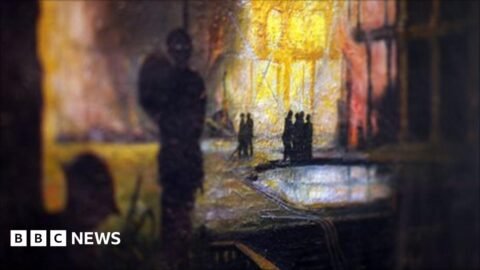
(Credits: Far Out / Dutch National Archives)
You won’t often hear the name Han Van Meegeren in the same sentence as the name Vermeer, but the two are intrinsically connected. Indeed, one could argue that van Meegeren, a Dutch painter alive in the late 19th century, was just as talented at producing art as the great Johannes Vermeer, who lived two centuries before. That’s because the former became most talented at forging the ‘Old Masters’ paintings.
Many critics have not legitimised van Meegeren for his works, but, on paper, he was a talented artist, having studied at the Royal Academy of Art in The Hague. Early in his career, van Meegeren became obsessed with trying to mimic paintings of the founding fathers of Flemish art. When he moved to the South of France with his wife in 1932, he set off to impeccably replicate the painting process of the ‘Old Masters’, acquiring the same 17th century canvases, mixing his paints with the same raw materials they would have used—lapis lazuli, white lead, cinnabar and more—and even building his own paint brushes from individual strands of badger fur.
One can’t help but admire the precision of the man’s process. He used formaldehyde to harden the paint to make it look centuries old and then baked the canvas so that cracks would form, indicating its age. Meegeren wanted to prove that he was just as talented as these artists; hence, replicating their work wasn’t difficult even hundreds of years later.
However, he didn’t exactly have a massive fan club; in fact, he was mostly criticised for having a talent that was limited to copying other artists’ work. He became outright blacklisted when after World War II, an arts commission, set up by the Allies, was established to return paintings that had been confiscated and collected by Nazi leaders.
The most famous example was van Meegeren’s Christ and the Woman Taken in Adultery, a forgery of Vermeer’s painting bought by Hermann Göring. On one hand, many viewed van Meegeren as a hero for having sold a forged painting to a Nazi official, but on the other hand, many attacked him for collaborating with the Nazis. In fact, he was arrested in 1945 on these charges.
During his trial, he confessed it was his original intention to reveal his authorship of the forgeries, but perhaps excitement got the best of him, and he got carried away. In fact, of van Meegeren’s 14 forgery works of Flemish baroque painters Vermeer and Pieter de Hooch, nine were sold at enormous profit, believed to be the originals.
Ultimately, even if van Meegeren grew his fame from copying artworks by ‘real’ artistic geniuses, we can applaud him for his cleverness in amassing wealth and praise for making copies that were so well-done they looked like the originals. In many ways, his perfect understanding of the science and the process behind these revered artworks that successfully duped swaths of people makes him just as talented.
Related Topics





